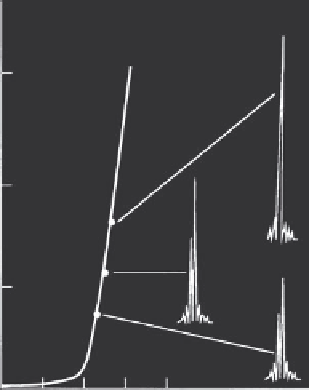Biomedical Engineering Reference
In-Depth Information
3
2
1
FIGURE 4.20
CW light versus current and spectral char-
acteristics of GaAs laser identical to that
shown in Figure 4.19 except that the cavity
length is 250 μm.
5
10
15 20
Current (mA)
at various modulation depths at modulating frequencies between 1 and
3 GHz. Note that a single-mode spectrum is achieved in the laser with a
125 μm cavity length at modulation depths up to 90% independent of mod-
ulating frequency, but multimode oscillation occurs at 75% modulation
depth independent of modulation frequency for the longer cavity laser. The
linewidths of individual modes will broaden as the frequency of modula-
tion increases but the amplitudes do not change. This can be explained as
a result of fluctuations in the cavity refractive index because of fluctuating
carrier density, that is, under constant optical modulation depth, the fluc-
tuations in carrier density increase with increasing modulation frequency,
so that line broadening is more visible at higher modulating frequencies.
For a homogeneously broadened gain spectrum (no mode jumping), when
the laser is biased to a certain optical power and is modulated at a high
frequency and the modulation depth controlled, the time averaged lasing
spectrum is equivalent to that of a laser-operating CW at a reduced power
level [35].
4.17.5 Modulation Depth and Signal-to-Noise Considerations
The emission spectrum of a single-mode laser under continuous microwave
modulation will exhibit a single longitudinal mode if the modulation depth
generally does not exceed 80%. If the modulation depth is increased above
80%, the lasing spectrum will begin to break into multimode oscillation. The
spectral dynamics can be estimated by observing the CW lasing spectrum at
various output levels. Another requirement for stable operation is to main-
tain the laser above threshold throughout modulation.

Search WWH ::

Custom Search